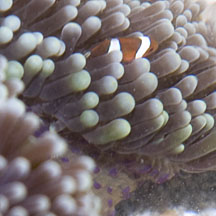 |
|
| fishes text index | photo index |
| Phylum Chordata > Subphylum Vertebrata > fishes > Family Pomacentridae |
| Anemonefishes Amphiprion sp. Family Pomacentridae updated Sep 2020
Where
seen? Made
famous by the cartoon "Finding Nemo", these fishes are
a delight and the highlight of a trip. Anemonefishes are commonly
seen among the sea anemones of our Southern shores. At low tide,
they may shelter in a pool nearby while their anemone is left
high and dry. |
 In a Magnificent anemone. Terumbu Semakau, Jul 14 |
 In a Merten's carpet anemone. Terumbu Hantu, Apr 12 |
 Stranded at low tide: best to leave it alone. Kusu Island, Aug 19 |
| How do they stay alive in a sea anemone? The anemonefish is believed to develop this immunity slowly. To
acclimatise to a host anemone, an anemonefish will at first gingerly
swim among the tentacles, touching it with its fins then withdrawing
rapidly, in an elaborate dance. Only after some time will the fish
be able to dive right in among the tentacles. One theory is that
the fish smears mucus from the anemone all over itself. In this
way, to the anemone, the fish is just another part of the anemone.
Thus the sea anemone doesn't sting the fish. Another theory is that
the mucus of the fish (all fishes are covered in mucus) lacks substances
that trigger a sea anemone to discharge its stingers. What do they eat? Anemonefishes eat mainly plankton. Some also graze algae from the surface or gathered from the water. |
 Fishes of several different sizes in one anemone. Pulau Pawai, Dec 09 Photo shared by Loh Kok Sheng on flickr. |
 Eggs laid near the host sea anemone. Terumbu Raya, Jun 15 Photo shared by Toh Chay Hoon on facebook. |
| Amazing gender switch: Anemonefishes
can change their gender. Often, a sea anemone will be home to several
anemonefishes of the same species. Usually the largest anemonefish
in the group is the female and the next largest is the functioning
male (although he is often less than half her size). If the female is removed from the
group, the male becomes a female and the next largest becomes the
dominant male. In this way, anemonefishes can continue to breed
throughout the year. Small anemonefishes are not necessarily younger,
just lower in the "pecking order". It is believed they
remain small because of the constant harassment by the dominant
pair.
Small anemonefishes are thus NOT the babies of larger anemonefishes in the same anemone.
Anemonefish babies: Anemonefishes form permanent pair bonds that sometimes last for years. The male usually selects the nest site, often a bare rock near the sea anemone which he clears of seaweeds and other rubbish. The female eventually helps out. After the female lays on the site, the male scrupulously guards and cares for the eggs, keeping them well aerated and clean. The female helps out sometimes. Larval fish that hatch from the eggs drift with plankton for 8-12 days before settling to the bottom and changing into a juvenile fish. How does the baby fish find an anemone host? Each species of anemonefish lives in a specific species of sea anemone. Some species apparently follow chemicals released by the suitable host anemone, others find one by sight, for yet others, it is apparently simply by chance. One study suggests the fishes use the smell of leaves from the rainforest to find their way to a suitable habitat. Even so, this is not the end of the problems for the young fish. If the anemone already has resident anemonefishes, the new fish is usually bullied by the residents and may even be driven away. |
Pulau Semakau, Apr 17 |
| Human uses: Unfortunately, these
fishes are taken in large numbers from the wild for the aquarium trade.
The harvest may involve the use of cyanide or blasting, which damage
the habitat and kill many other creatures. Like other fish and creatures
harvested from the wild, most die before they can reach the retailers.
Without professional care, most die soon after they are sold. Often
of starvation as owners are unable to provide the small creatures
and plants that these fishes need to survive. In artificial conditions,
many succumb to diseases and poor health. Those that do survive are
unlikely to breed. There have been some success in breeding anemonefish for the aquarium trade. Although captive bred anemonefish are hardier, they are more expensive. Harvesting from the wild will probably continue so long as there are unscrupulous traders and aquarists. Thus, anemonefishes continue to be unsustainably harvested from the wild. The pressure on wild populations has risen tremendously due to the huge demand following the popular "Finding Nemo" cartoon. Status and threats: All our anemonefishes are 'Vulnerable' in the Red List of threatened animals of Singapore. Like other creatures of the intertidal zone, they are affected by human activities such as reclamation and pollution. Poaching by hobbyists and overfishing can also have an impact on local populations. According to the Singapore Red Data Book, "habitat protection and strict policing against illegal collection are required" to conserve our anemonefishes. |
| Some Anemonefishes on Singapore shores |
| Amphiprion species recorded for Singapore from Wee Y.C. and Peter K. L. Ng. 1994. A First Look at Biodiversity in Singapore. *additions from from Ng, P. K. L. & Y. C. Wee, 1994. The Singapore Red Data Book: Threatened Plants and Animals of Singapore. in red are those listed among the threatened animals of Singapore from Davison, G.W. H. and P. K. L. Ng and Ho Hua Chew, 2008. The Singapore Red Data Book: Threatened plants and animals of Singapore. **from WORMS +Other additions (Singapore Biodiversity Records, etc)
|
Links
|

